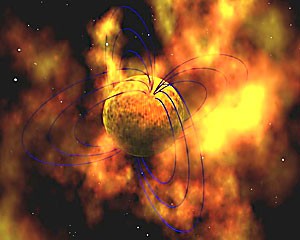UA physicists have traced the source of extremely high-energy bursts of radiation from deep space back to objects called magnetars, and they’ve pinned down the exact location on a magnetar from which the bursts emerge, solving a decades-old puzzle.
Magnetars are a type of neutron star – the leftover core of a supernova explosion that occurs at the end of a massive star’s life – and are characterized by their intense magnetic fields, said Fulvio Melia, a physics and astronomy professor.
In one-tenth of a second, the bursts produce the equivalent energy output of the sun, said Feryal Ozel, a physics and astronomy professor.
The existence of magnetars was proposed in the early 1990s by Robert Duncan, an astronomer at the University of Texas at Austin, as a possible explanation for the source of the high-energy bursts, according to Duncan’s Web site.
Until now, however, the precise location of the magnetar from which the bursts originate had been a mystery, Ozel said.
“”It’s the frontier of physics,”” she said. “”We are dealing with the densest form of matter in the current universe, and on top of that, we’re dealing with the most energetic phenomena in the current universe.””
Neutron stars pack the mass of one and a half suns into a sphere with the radius the length of Chicago, Melia said.
One teaspoon of neutron star matter weighs as much as Mount Everest, Ozel said.
The stars also spin extremely fast, some executing a full revolution in a few thousandths of a second, Melia said.
With magnetic fields that are more than 100 trillion times stronger than that of Earth, magnetars are home to the highest magnetic fields in the universe, Ozel said.
In a collaboration with two members of NASA’s Marshall Space Flight Center in Huntsville, Ala., Ozel and visiting graduate student Tolga Guver used data from the XXM-Newton Observatory and a computer model to determine the precise origin of the powerful blasts of radiation.
The results of the study, published in the Sept. 20 edition of the Astrophysical Journal Letters, show that the bursts are emitted from small patches on the surfaces of magnetars called magnetic islands, Ozel said.
“”By comparing our theoretical model (to the data), we can say, yes, there is a magnetic island on the neutron star that became activated during this initial phase of the outburst,”” she said.
“”This island extends a few meters below the hard surface of the star, and that’s where the energy is being stored,”” she added.
Now that the precise origins of the high-energy bursts are known, the next step is to determine how or why the bursts occur, Ozel said.
One possibility is that there are earthquakes on the surface of magnetars, Ozel said.
“”These magnetic fields are producing so much stress on the crusts (of the magnetars), at some point it just gives – yields to the stress – and produces this massive earthquake, and you see the ringing of this earthquake for years,”” she said.
While the recent findings involve a magnetar 12 million light years from Earth, the study has implications closer to home.
“”I like to see it as this nice interface between our understanding of the physical world overall, and our understanding of astronomical objects – using one to advance the other,”” Ozel said.
“”It’s a big explosion, and explosions are fun.””









